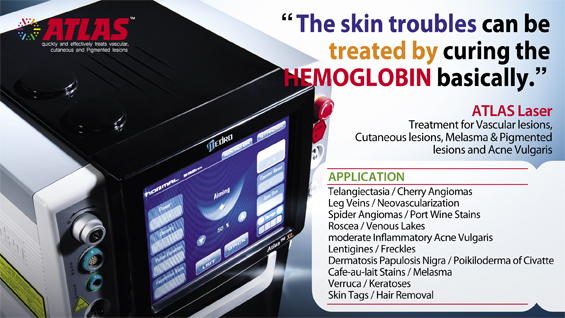▶ Previous Artlcle : #2-2. Port-wine Stain
The previous article discussed about treatment of port-wine stains using pulsed dye laser (PDL). This article, the last one of the series, will cover laser treatments other than dye laser and other treatment modalities.
Port-wine stains are characterized by venectasia or talengiectasia in the upper dermis. Therefore, the vessel diameter of lesions vary from 10-150μm, which contributes to the inconsistency in treatment outcome. In the concept of selective photothermolysis, setting the appropriate pulse duration is very hard and complicated because of vessels with various diameters in the target lesion.
[Advertisement] ATLAS(Long pulse 532nm & 940nm dual wavelength) – Manufacturer: MEDRO(www.medro.net)
Small vessels of 20 μm or less can be thought to be easily destroyed, however, they tend to deliver the received energy easily to the surrounding tissues making it difficult to completely remove them. Partially damaged vessels may be reperfused and repaired by the regenerative mechanism which makes it difficult to treat.
Vascular lasers other than PDL include Long Pulsed 755nm Alexandrite laser, Intense Pulsed Light (IPL), Long Pulse Nd:YAG laser, and KTP laser, etc.
1064nm Nd:YAG Laser
The 1064nm Nd:YAG laser is the most widely used laser for vascular and pigment lesions. Nd:YAG, which refers to a medium, stands for ‘Neodymium:Yttrium-Aluminium-Garnet’. This laser with the crystal medium does not need replacing like the dye laser, and its excellent durability and affordability make it widely available.
One disadvantage of this laser would be that its wavelength is not as readily absorbed in hemoglobin as 585~595nm of PDL. The energy is absorbed in similar amount as those absorbed in melanin allowing less interference from melanin. It also requires higher energy to compensate for low absorption into red blood cells. However, it has the advantage of thermocoagulating deep vessels of 5-6mm with its long wavelengths and is effective in selective treatment of bluish, thick vessels lying in the deeper layers. The high energy and lower vascular selectivity may cause heat damage to adjacent tissues. Therefore the spot size is being reduced to improve vascular selectivity but the risk of epidermal burn or scarring still remains.
Frequency Doubled 532nm Nd:YAG Laser
KTP laser has half the wavelength of 1064nm Nd:YAG laser using KTP (Potassium Tytanil Phosphate) crystal. The 532nm wavelength is easily absorbed into both the oxyhemoglobin and melanin.
The Q-switched mode with the pulse duration in nanoseconds can be used for pigment lesions while the long pulse mode with pulse duration of milliseconds can be used for vascular anomaly. Since the transmittance depth is shallow, it is mainly used for small superficial vessels. As it can also be absorbed into melanin and affect pigmentation, superficial heat damage may cause epidermal disruption and skin discoloration as side effects.
IPL (Intense Pulsed Light)
With proper adjustment of the cut-off filter and pulse duration, the non-laser device IPL can also be used in vascular anomaly. As combinations of various parameters are possible, a seasoned clinician can effectively treat a wide range of vascular lesions using IPL. However, since the crystal part of the handpiece comes in direct contact with the skin and pressure from the handpiece can compress the target vessels, it may lower the treatment efficacy. Therefore, the experience of clinician is the key factor determinining the outcome.
-To be continued-
▶ Next Artlcle : #3-2. Treatment of Port-wine Stains





















